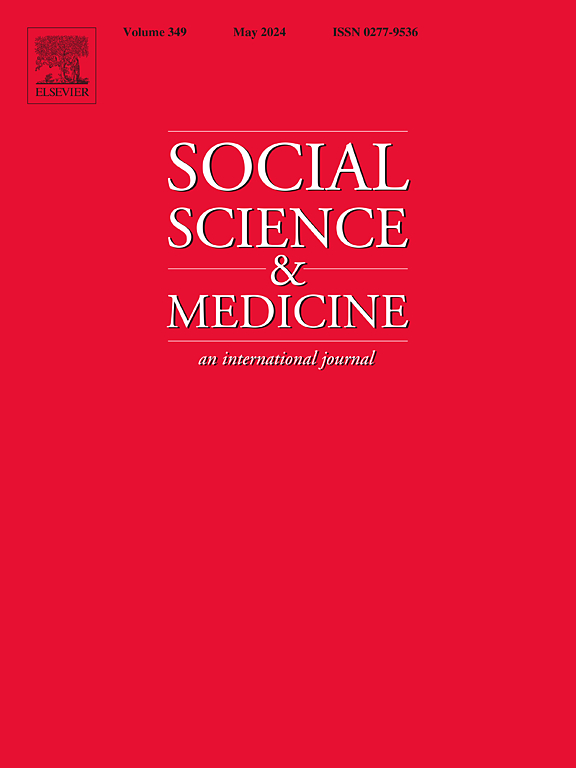大学生饮食失调诊断的不公平:个体异质性和歧视准确性的交叉多水平分析(MAIHDA)
IF 5
2区 医学
Q1 PUBLIC, ENVIRONMENTAL & OCCUPATIONAL HEALTH
引用次数: 0
摘要
饮食失调在许多领域都对健康产生负面影响。尽管这些问题往往会产生令人衰弱的影响,但它们仍未得到充分研究,尤其是那些被多重权力和压迫结构系统边缘化的人的经历。交叉性框架强调了这些系统相互构成的本质,以及它们独特地塑造人群内部和人群之间生活经验的方式。我们使用来自美国大学健康协会全国大学健康评估III (ACHA-NCHA III)的数据,这是一项对大学生的重复横断面调查,通过个体异质性和歧视性准确性的多层次分析(MAIHDA)来估计性别认同、性取向、种族/民族和父母教育交叉路口饮食失调诊断的患病率。我们拟合了两个模型,一个模型只评估了阶层特异性的差异,另一个模型则将种族/民族、性别认同、性取向和父母教育作为主要影响因素。样本中饮食失调诊断的患病率为5.13%,不同阶层的患病率估计从父母拥有学士学位的黑人、直男、顺性别男性的0.44%到父母拥有学士学位以上的跨性别、非二元性、双性恋/泛性恋、原住民的19.20%不等。性别认同有很大的主要影响,包括跨性别和非二元个体在内的阶层患饮食失调的几率是顺性男性的6.55倍(95% CI: 5.70-7.51)。性别认同、性取向、种族/民族和父母教育之间的交互作用导致父母学历低于本科的白人、双性恋/泛性恋、顺性女性的患病率高出2.66%,父母学历低于本科的白人、男同性恋/女同性恋、跨性别者和非二元性别者的患病率低2.93%。这些发现强调了在大学生饮食失调诊断中的不平等,并呼吁人们关注塑造他们的多重、连锁的权力和压迫系统。本文章由计算机程序翻译,如有差异,请以英文原文为准。
Inequities in eating disorder diagnoses in college students: An intersectional multilevel analysis of individual heterogeneity and discriminatory accuracy (MAIHDA)
Eating disorders contribute significantly to negative health outcomes across a broad range of domains. Despite their often-debilitating effects, they remain understudied, especially with respect to the experiences of people who are marginalized by multiple structural systems of power and oppression. The intersectionality framework highlights the mutually constitutive nature of those systems and the ways by which they uniquely shape lived experiences within and between populations. We used data from the American College Health Association National College Health Assessment III (ACHA-NCHA III), a repeated cross-sectional survey of college students, to estimate the prevalence of eating disorder diagnoses across intersections of gender identity, sexual orientation, race/ethnicity, and parental education via a Multilevel Analysis of Individual Heterogeneity and Discriminatory Accuracy (MAIHDA). Two models were fit, one assessing only stratum-specific variations and another including race/ethnicity, gender identity, sexual orientation, and parental education as main effects. The prevalence of eating disorder diagnoses in the sample was 5.13 %, with stratum-specific prevalence estimates ranging from 0.44 % for Black, straight, cisgender men whose parents have a bachelor's degree to 19.20 % for transfeminine and nonbinary, bisexual/pansexual, Indigenous people whose parents have more than a bachelor's degree. There was a large main effect of gender identity, with strata inclusive of transfeminine and nonbinary individuals having 6.55 times greater odds (95 % CI: 5.70–7.51) of eating disorder diagnoses compared to cisgender men. Intersectional interactions between gender identity, sexual orientation, race/ethnicity, and parental education contributed to 2.66 % excess prevalence among White, bisexual/pansexual, cisgender women whose parents had less than a bachelor's degree, and 2.93 % lower prevalence among White, gay/lesbian, transfeminine and nonbinary people whose parents had less than a bachelor's degree. These findings emphasize the concerning inequities in eating disorder diagnoses among college students, and call attention to the multiple, interlocking systems of power and oppression that shape them.
求助全文
通过发布文献求助,成功后即可免费获取论文全文。
去求助
来源期刊

Social Science & Medicine
PUBLIC, ENVIRONMENTAL & OCCUPATIONAL HEALTH-
CiteScore
9.10
自引率
5.60%
发文量
762
审稿时长
38 days
期刊介绍:
Social Science & Medicine provides an international and interdisciplinary forum for the dissemination of social science research on health. We publish original research articles (both empirical and theoretical), reviews, position papers and commentaries on health issues, to inform current research, policy and practice in all areas of common interest to social scientists, health practitioners, and policy makers. The journal publishes material relevant to any aspect of health from a wide range of social science disciplines (anthropology, economics, epidemiology, geography, policy, psychology, and sociology), and material relevant to the social sciences from any of the professions concerned with physical and mental health, health care, clinical practice, and health policy and organization. We encourage material which is of general interest to an international readership.
 求助内容:
求助内容: 应助结果提醒方式:
应助结果提醒方式:


